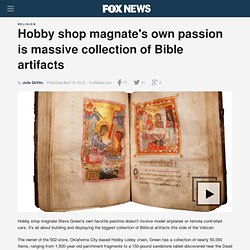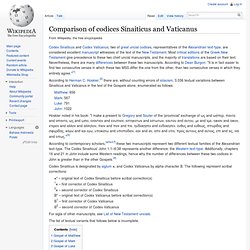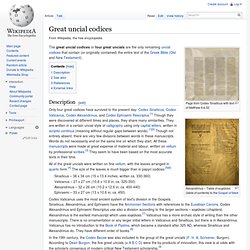

1500-year-old gospel kept in Ankara excites Vatican, report claims. The Vatican has requested that Turkey allow it to examine a 1500-year-old copy of an apocryphal gospel that was discovered by Turkish police during an anti-smuggling operation in 2000 and handed over to the Ankara Ethnography Museum, the Turkish Bugün daily reported on Thursday.

The daily said the document is reportedly written in Aramaic, the language Jesus is thought to have spoken, and is said to be worth TL 40 million. According to the report, the document was seized from a gang smuggling artifacts during a police operation in southern Turkey in 2010 and reportedly preserves its originality and many traces of the period it's from. Vatican Requests 1,500-Year-Old Bible Held In Turkey. The Bible of William Hannay of Tundergarth, Dumfriesshire.

No Photos of the Turkish Bible are available at this time. The Vatican has allegedly issued an official request to examine a 1,500-year-old Bible that has been held in Turkey for the past 12 years, the Hurriyet Daily News reports. The Bible reportedly contains early teachings of Jesus Christ and is written in gold lettering on animal hide in Syriac, a dialect of Aramaic, which was the native tongue of Jesus. According to a report by National Turk, the Bible was seized from a gang of smugglers in a Mediterranean-area operation. The earliest Markan manuscript fragment? Free NET Bible and Thousands of Bible Studies. Daniel B. Wallace. Fragments of Mark's Gospel May Date to 1st Century.
First-Century Fragment of Mark’s Gospel Found!? « Daniel B. Wallace. Hobby shop magnate's own passion is massive collection of Bible artifacts. This manuscript contains the Gospels, Eusebian Canon Tables and portraits of the Evangelists.

Each Gospel begins with a folio written with gold-over-magenta. Similar to other eastern Mediterranean and Palestinian Gospel manuscripts, it was copied in 1156 for the John of Crete, Archbishop of Cyprus. Hobby shop magnate Steve Green's own favorite pastime doesn't involve model airplanes or remote controlled cars, it's all about building and displaying the biggest collection of Biblical artifacts this side of the Vatican. The owner of the 502-store, Oklahoma City-based Hobby Lobby chain, Green has a collection of nearly 50,000 Items, ranging from 1,500-year-old parchment fragments to a 150-pound sandstone tablet discovered near the Dead Sea.
Ancient Dinosaur Depictions. To the right is a picture of a dinosaur fighting a mammoth from the book Buried Alive by Dr.

Jack Cuozzo (click to enlarge). Revealed: The scandalous history of Judaism's most precious book. A new book by a Times of Israel reporter reveals dramatic new information about the fate of a manuscript many consider Judaism’s most important book — the 1,100-year-old Aleppo Codex.

Jesus as Θεός (God): A Textual Examination. Editor’s Note: This paper was originally given at the Evangelical Theological Society’s southwestern regional meeting, held at Southwestern Baptist Seminary on March 23, 2007.

Brian was one of my interns for the 2006-07 school year at Dallas Seminary. He did an outstanding job in presenting the case that the original New Testament certainly affirmed the deity of Christ. Daniel B. Wallace Note: For a less academic treatment on this article go to Jesus as “God”: Scriptural Fact or Scribal Fantasy? From Aland to Zuntz, every major NT scholar has explored the canon of the NT for texts that call Jesus θεός.2 While this may seem like a painless pursuit with plenty of “proof-passages,” several stumbling blocks quickly emerge.3 When, then, did this boldness to call Jesus θεός begin? Second Century Papyri. The Great Uncial Codices. Another manuscript with a dramatic history, this one, which contains the gospels and Acts, first appears in the hands of the bishop of Clermont at the Council of Trent, where it was used by that worthy in an attempt to lay a biblical foundation for celibacy.

(At John 21:22, D reads: "if I wish him to remain thus until I Come. " It is the only Greek manuscript that has "thus" in this passage, although this reading is found in the Latin Vulgate.) After a subsequent checkered history the manuscript finally came into the possession of Theodore Beza, the heir of John Calvin in Geneva, who presented it to Cambridge University in 1581. It's important to scholar in two respects.
First, it is the earliest known New Testament manuscript written in both Greek and Latin, having a Greek text and a Latin translation on facing pages. Differences between codices Sinaiticus and Vaticanus. Codex Sinaiticus and Codex Vaticanus, two of great uncial codices, representatives of the Alexandrian text-type, are considered excellent manuscript witnesses of the text of the New Testament.

Most critical editions of the Greek New Testament give precedence to these two chief uncial manuscripts, and the majority of translations are based on their text. Nevertheless, there are many differences between these two manuscripts. According to Dean Burgon: "It is in fact easier to find two consecutive verses in which these two MSS differ the one from the other, than two consecutive verses in which they entirely agree.
Great uncial codices. Page from Codex Sinaiticus with text of Matthew 6:4-32 Alexandrinus – Table of κεφάλαια (table of contents) to the Gospel of Mark The great uncial codices or four great uncials are the only remaining uncial codices that contain (or originally contained) the entire text of the Greek Bible (Old and New Testament).

Description[edit] Only four great codices have survived to the present day: Codex Sinaiticus, Codex Vaticanus, Codex Alexandrinus, and Codex Ephraemi Rescriptus.[1] Though they were discovered at different times and places, they share many similarities. They are written in a certain uncial style of calligraphy using only capital letters, written in scriptio continua (meaning without regular gaps between words).[1][2] Though not entirely absent, there are very few divisions between words in these manuscripts.
Codex Vaticanus. The Codex Vaticanus (The Vatican, Bibl.

Vat., Vat. gr. 1209; no. B or 03 Gregory-Aland, δ 1 von Soden), is one of the oldest extant manuscripts of the Greek Bible (Old and New Testament), one of the four great uncial codices.[1] The Codex is named after its place of conservation in the Vatican Library, where it has been kept since at least the 15th century.[2] It is written on 759 leaves of vellum in uncial letters and has been dated palaeographically to the 4th century.[3][4] The manuscript became known to Western scholars as a result of correspondence between Erasmus and the prefects of the Vatican Library. Codex Sinaiticus. Codex Sinaiticus (Greek: Σιναϊτικός Κώδικας, Hebrew: קודקס סינאיטיקוס; Shelfmarks and references: London, Brit. Libr., Additional Manuscripts 43725; Gregory-Aland nº א [Aleph] or 01, [Soden δ 2]) or "Sinai Bible" is one of the four great uncial codices, an ancient, handwritten copy of the Greek Bible.[1] The codex is a celebrated historical treasure.[2] The codex is an Alexandrian text-type manuscript written in the 4th century in uncial letters on parchment.
Are there any original New Testament manuscripts in existence. All we have are copies, of copies, of copies of the alleged originals. When were the gospels written and by whom. By Matt Slick Dating the gospels is very important. If it can be established that the gospels were written early, say before the year A.D. 70, then we would have good reason for believing that they were written by the disciples of Jesus himself. If they were written by the disciples, then their reliability, authenticity, and accuracy are better substantiated. Also, if they were written early, this would mean that there would not have been enough time for myth to creep into the gospel accounts since it was the eyewitnesses to Christ's life that wrote them. Furthermore, those who were alive at the time of the events could have countered the gospel accounts; and since we have no contradictory writings to the gospels, their early authorship as well as apostolic authorship becomes even more critical.
Destruction of the temple in A.D. 70, Luke and Acts. Manuscript evidence for superior New Testament reliability. By Matt Slick The New Testament is constantly under attack, and its reliability and accuracy are often contested by critics. If the critics want to disregard the New Testament, then they must also disregard other ancient writings by Plato, Aristotle, and Homer. This is because the New Testament documents are better-preserved and more numerous than any other ancient writings. Because they are so numerous, they can be cross checked for accuracy... and they are very consistent. There are presently 5,686 Greek manuscripts in existence today for the New Testament. As you can see, there are thousands more New Testament Greek manuscripts than any other ancient writing. Psalms 12 (Blue Letter Bible: KJV - King James Version)
First century fragment of Mark? Dr. Scott Carroll (drscottcarroll) Ehrman-Wallace Debate Wrap-Up. Thanks to those of you who were following my tweets from the debate. As promised, here are some further reflections on last night’s debate between Bart Ehrman and Dan Wallace. First of all, both men did a good job presenting their case and responding to each other’s questions. Bart Ehrman is a skilled debater and a very gifted communicator.
He took charge of the debate from the very beginning, communicating clearly and directly. Home Page. Www.reclaimingthemind.org/blog/2012/02/wallace-vs-erhman-round-three/ Community.logos.com/forums/t/45166.aspx?PageIndex=2. OT: 1st Century Fragment of Mark's Gospel Discovered - Logos Bible Software Forums. Greg Masone | Forum Activity | Posted: Mon, Feb 6 2012 6:42 PM I came across some neat news that I'm sure many here can appreciate. According to Daniel B. Wallace, a 1st century fragment of Mark's Gospel has recently been discovered. Aside from that information, not much can be released as it is currently being studied. The results are due for publication within a year. Newly-Identified Early New Testament Fragments? « Larry Hurtado's Blog. Over the last couple of days have appeared numerous postings on reports that fragments of several early NT manuscripts have been identified (e.g., A statement by Dan Wallace in a recent debate with Bart Ehrman seems to be the source of these reports.
Textualcriticism : Message: RE: [textualcriticism] Very early fragment of Mark? On 02/21/2012 12:14 PM, Daniel Buck "bucksburg" wrote: --- In textualcriticism@yahoogroups.com, David Palmer wrote: >Daniel, thanks for those comparisons of variants in Sinaiticus; that was a good idea, I'll check that out myself. The Green Collection. First century Mark fragment and extensive papyrus/i? Dan Wallace has now further specified his claim that there is an unpublished manuscript of Mark which is likely to be first century. Stand to Reason Blog: First-Century Gospel Fragment? Brill Publishers. Brill (Euronext: BRILL) (known as E. J. Brill, Koninklijke Brill, Brill Academic Publishers) is an international academic publisher founded in 1683 in Leiden, Netherlands. With offices in Leiden and Boston, Brill today publishes more than 134 journals[1] and around 600 new books and reference works each year. In addition, Brill is a provider of primary source materials online and on microform for researchers in the humanities and social sciences through its imprint IDC Publishers.
Areas of publication[edit] Earlier Fragment of Mark’s Gospel Rumored to Be Found. The Story: "There's nothing more likely to get the blogs all talking than a rumor about a newly discovered manuscript fragment. " That line is just begging for a qualification. Dr. Wallace: Earliest Manuscript of the New Testament Discovered? - Daniel B. Wallace. Note: Several websites (NT Blog, Gospel Coalition, Andreas Köstenberger, Evangelical Textual Criticism, Hypotyposeis, etc.) have been writing about Dan Wallace's comments to Bart Erhman about the discovery of several New Testament papyri. Israel's #1 News Site. Lexicon. Python Programming Language – Official Website. With 5 Million More Euros in the Bank, Pearltrees Gets Ready to Scale and Start Monetizing.